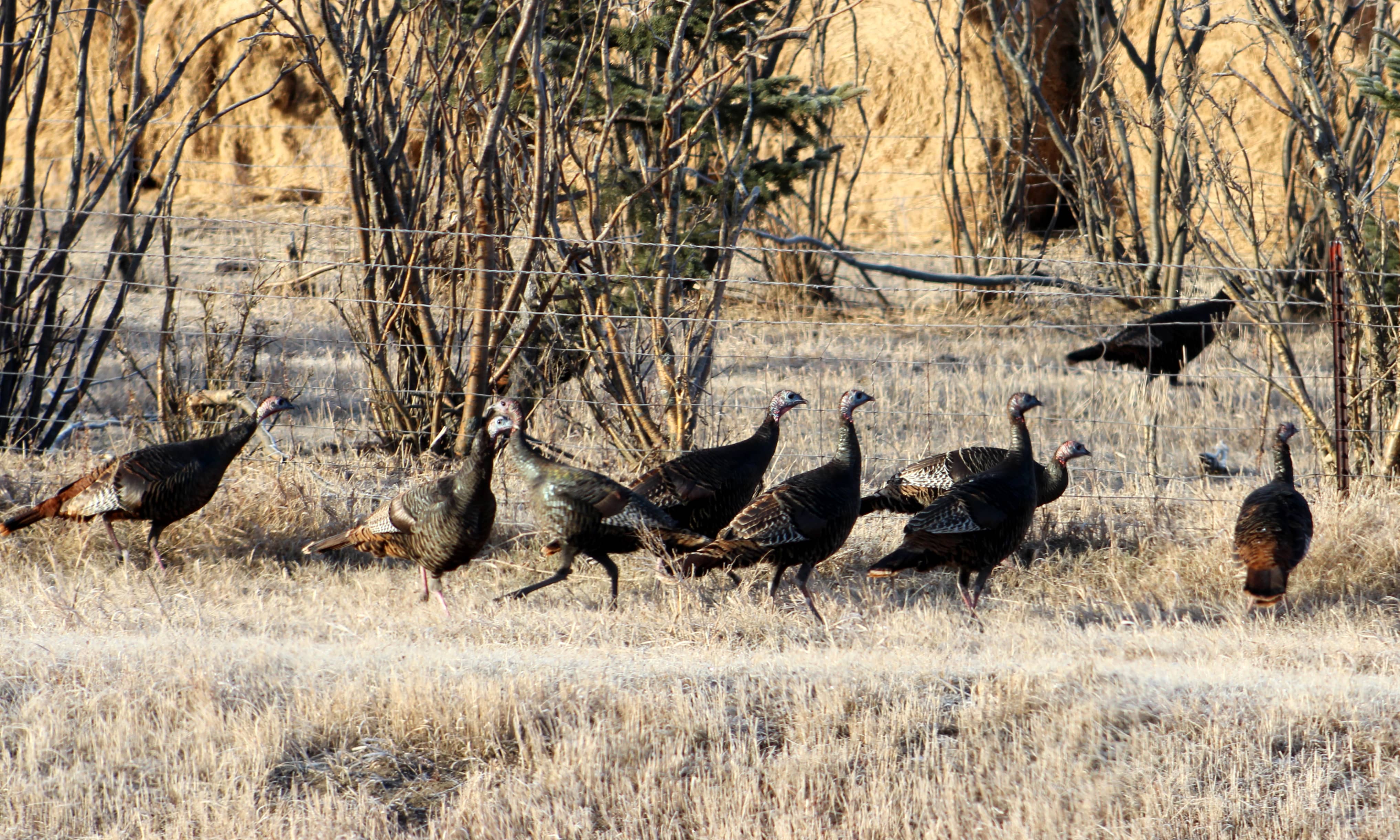
Fenceline Flock. Wild turkey numbers in North Dakota are on the rise, along with hunting opportunities as increased tags and improved access align for a strong spring season in the state. Simonson Photo.
By Nick Simonson
With the deadline looming for spring turkey hunting applications to be submitted by Feb. 16, there’s reason for optimism across North Dakota, and increased opportunities have set the stage for new hunters looking to explore the pastime.
The thoughts of warmer spring days to come paired with expanded habitat programs spearheaded by the National Wild Turkey Federation (NWTF) and simple ways for hunters to get out and pursue the state’s biggest upland birds has Clayton Lenk, NWTF District Biologist seeing a strong present and bright future for turkey hunting across Roughrider Territory.
“Things are looking pretty good. There was some question probably with a lot of the droughts we were having last year, but overall, the turkey numbers seem to be doing alright. There’s an actual increase by about 600 and some tags this year compared to last year. So those hunter success rates are still up,” Lenk comments on the upcoming North Dakota spring turkey season running from April 9 through May 15.
Biological Basics for Good Hunts
From a biological standpoint, Lenk encourages hunters to target spring toms on lands that have good roosting areas with open spaces such as fields nearby where they can strut and feed. Talking with landowners in the spring as to where turkeys are at, when they’re moving, and for access is a great way to find huntable populations and build sportsman-landowner relations. Listening to the noises tom turkeys make, or viewing online videos and tutorials pertaining to calling methods are the best ways to find out what triggers the competitive males in spring, and to move up the learning curve in calling techniques.
Additionally, Lenk recommends a simple decoy set-up with a couple of hen decoys and a tom decoy at most, when not moving around or spot-and-stalking turkeys in an area. Concealment from the turkeys’ sharp eyesight is also key and utilizing a blind or sitting in the open with full body camo and some natural objects for cover such as brush or a tree trunk will help with a hunt.
Covering up hands with gloves and the face with a camouflage mask takes care of those areas of exposed skin which are otherwise easily seen by turkeys moving through an area. When a tom does move into a position allowing for a shot, making only slight movements when the bird is looking away or distracted is the best means of getting ready to fire without spooking it.
Working for Better Habitat
NWTF continues its mission of improving both habitat and access for hunters in North Dakota, focusing on those regions where bird numbers are plentiful, and those spaces they utilize the most. Lenk highlights recent successes in partnering with government agencies and others over the past 12 months in improving places for both turkey populations and usage by hunters in the coming season.
“Riparian areas are a big push of ours in both of the Dakotas. So, any opportunity that we get to partner with different folks – whether it be Game & Fish, Forest Service, Fish and Wildlife, whomever – to try and get work done in those riparian areas not just from a water quality standpoint but also a habitat standpoint. From the turkey aspect, those riparian areas are pretty much where the turkeys are going to be in North Dakota just because of the topography and the land uses. A lot of the projects we do are focused in those riparian areas,” Lenk details.
Currently, NWTF fundraising efforts by the North Dakota chapter are underway for their programs in the state. With three statewide spring turkey hunting auction tags provided to them by the North Dakota Game & Fish Department (NDG&F), the organization opens opportunities to hunters looking to come to the Peace Garden State and experience a hunt which is typically reserved for residents only. A single spring turkey tag is auctioned off for those looking for a great do-it-yourself opportunity, along with a pair of tags and lodging with access to prime hunting areas as the other package, to help increase the funds available for NWTF projects.
“Each year the North Dakota state chapter of NWTF allocates member-generated dollars from banquets and [fundraising]. They allocate those types of dollars to habitat projects, whether it be partner projects, like we just approved one this year for some access for the forest service in southwestern North Dakota to try and help increase access on some of their properties out there.”
More information on NWTF, including hunting tips, habitat projects and recent regional successes can be found at nwtf.org, and the organization’s ND turkey tag auctions can be found online at: events.nwtf.org/340020-2022
